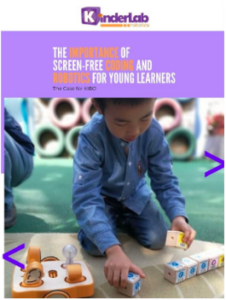Tufts Now: Training Teachers on Educational Technology, Now and for the Future
The Early Childhood Technology graduate certificate program from Tufts University empowers educators of young children to evaluate and use technologies as tools through which children can learn and create.
About the Tufts ECT Program
“Over this past year, we were forced to innovate and do things in education we hadn’t done before. It can be easy to go back to normal, but innovation is important. This is a leapfrog moment where we can make a huge leap forward in terms of what we’re doing with education and with educational technology,” said Amanda Sullivan, a doctorate in child development from Tufts and helped launch the Tufts Early Childhood Technology (ECT) certificate program five years ago with Marina Umaschi Bers, chair of the Eliot-Pearson Department of Child Study & Human Development and director of the interdisciplinary DevTech Research Group.
Innovation was the goal behind the establishment of ECT. Bers’ vision drove the creation of a graduate program of study in which those interested in the education of young children could not only learn how to use our current technologies, but the technologies of the future. “Technologies are constantly changing. That is their nature. Therefore, we need to provide intellectual tools, alongside technological skills, so educators can learn how to learn and develop their own confidence as learners,” said Marina Bers.
Building teachers’ confidence to navigate challenges more easily during the pandemic and in the future is a primary goal of the ECT program, which aims to help educators of young children develop knowledge and skills in technology, coding and engineering through playful, developmentally appropriate learning.
One such area of research is the Positive Technological Development (PTD) framework developed by Bers, which proposes six positive behaviors that should be supported by educational technologies. Known as the six C’s, they are: content creation, creativity, communication, collaboration, community building and choices of conduct.
“The PTD framework is one of our foundational pedagogies because we’re talking not about the tools themselves, but what they afford and what the opportunities are in terms of holistic, psychosocial behaviors, which all kids need to develop,” said Amanda Strawhacker, associate director of the ECT program. “And we know how to design and teach with technology so that it can become a great tool for all kinds of learning.”
About KIBO
The KIBO Robot, a robotics construction set for young children developed by the DevTech Research Group that uses wooden programming blocks but does not involve screen time, is one example of educational technology that encourages the six C’s.
Ebyn Brinkley, an ECT student and teacher from Norfolk, Virginia, enrolled in the program after her school district introduced the KIBO Robot to second-grade students a few years ago. She said the ability to evaluate tools and create a purposeful learning space is one of the main concepts she’ll take away from the program.
“I want to make sure that the kids have a way to create what they’re doing and not just be told what they’re doing,” said Brinkley, who has taught grades one through three for 16 years. “They can express what they learned in their own creative way. Children, and people in general, see things differently. I don’t want a child to think they’re wrong just because they see things differently.”
Sullivan echoed Brinkley’s emphasis on self-expression — one of the questions Sullivan often thinks about is: How can we use technology in more meaningful and deeper ways as a mode of self-expression and communication, not just learning about technology, but demonstrating learning through it?
ECT provides the opportunity for educators to take courses with instructors who are involved in cutting-edge research and implementation all over the world.
Read on for the full article.



















